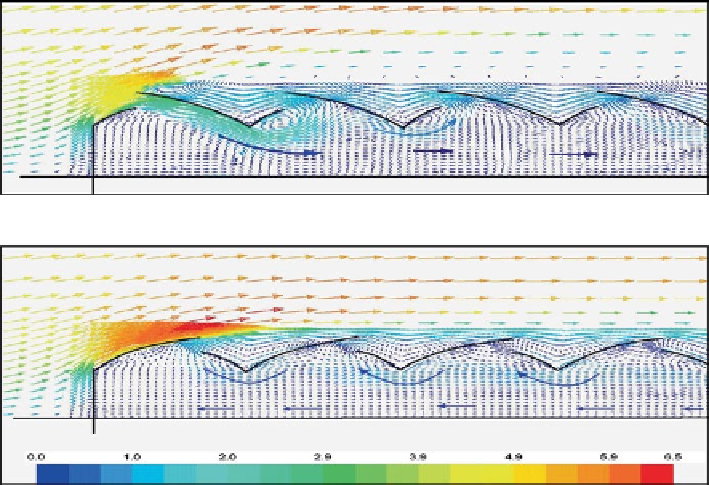Agriculture Reference
In-Depth Information
WINDWARD VENTILATION
LEEWARD VENTILATION
Fig. 10.13
A
C
omputational
F
luid
D
ynamic (CFD) simulation of air flow patterns in a greenhouse
with roof openings under windward (
top
) and leeward (
bottom
) ventilation. (Source: Montero
et al.
2011
)
by side openings may not be sufficient. To protect the crop from insect invasion,
roof and side openings are usually covered with insect-proof screens which not only
reduce the ventilation rate, but also affect all other microclimatic variables (Teitel
2001
,
2007
; Teitel et al.
2006
). Teitel et al. (
2012
) measured radiation distribution
in three greenhouses with different roof configurations and clearly showed that roof
openings, including the construction elements and insect-proof screens hindered the
supply of sufficient radiation to the canopy.
Montero et al. (
2011
) indicated a significant difference between leeward and
windward ventilation (Fig.
10.13
), where the windward ventilation internal air flow
was in the same direction as the external wind but in leeward ventilation the internal
air flow direction was opposite to the external.
Teitel and Tanny (
2005
) have shown that in leeward ventilation, if the wind is
not perpendicular to the plane of the openings there are outflow and inflow, at the
windward and leeward edges of the openings respectively. A wind blowing from
the back of the openings and nearly perpendicular to them reduced the mean air
velocity at the two edges but did not change the turbulent velocity much. Teitel and
Tanny (
1999
) demonstrated by experiments and theoretical models how the sud-
den opening of roof windows in a greenhouse affects the temporal variation in the
inside temperature and humidity. The results showed that the effect of the ventila-
tion (i.e. the reduction with time in the temperature and humidity ratio within the

